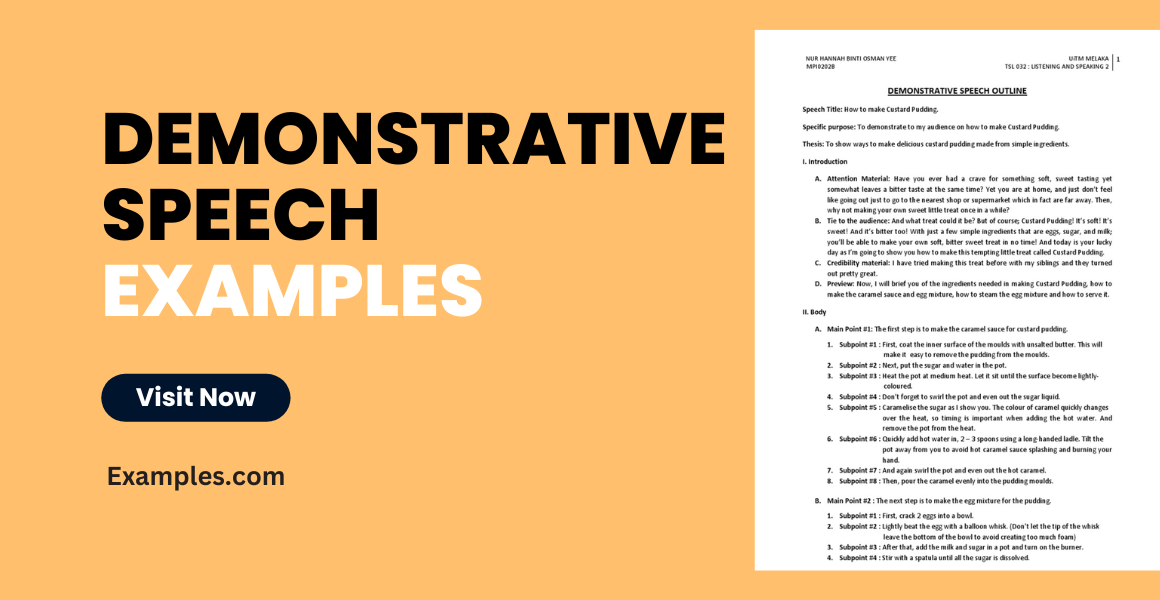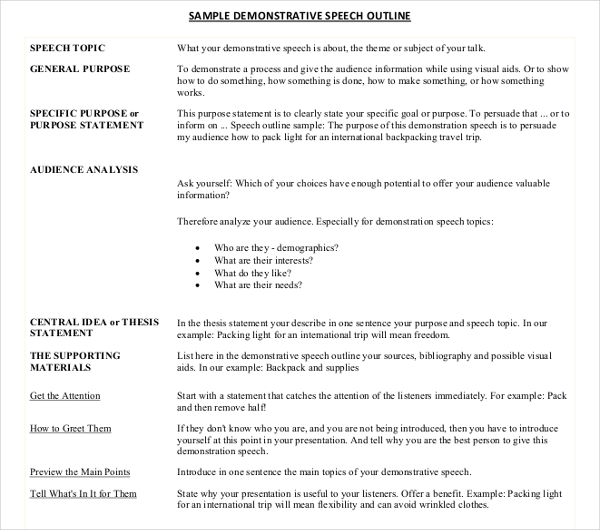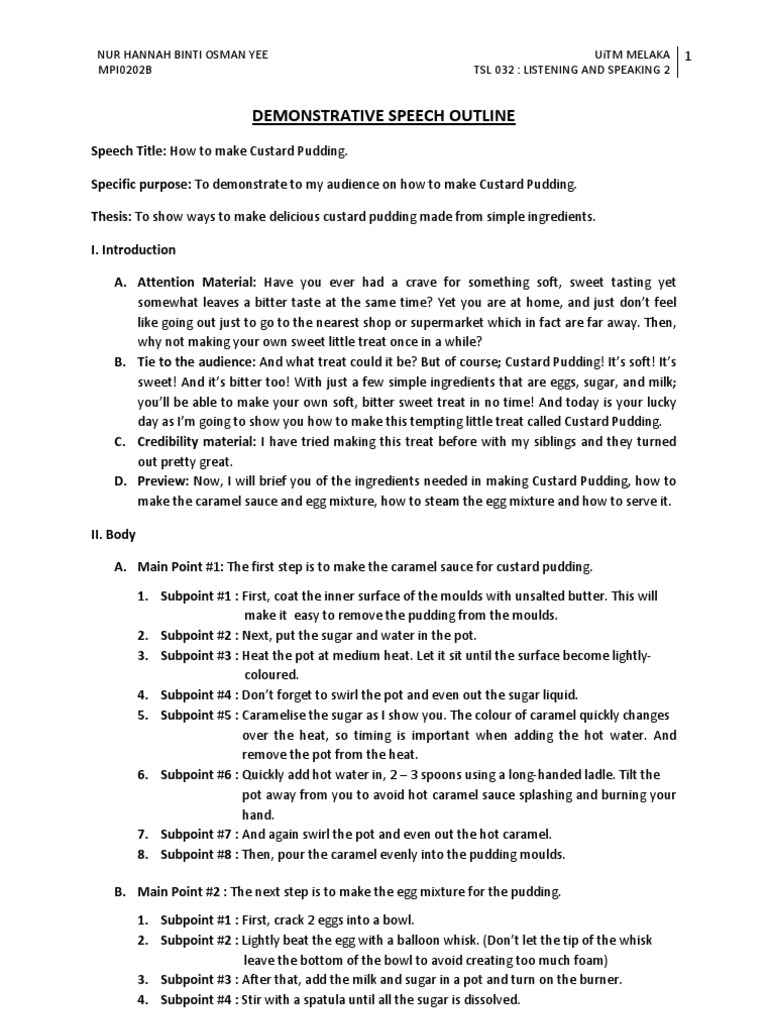Demonstrative Speech Examples to Download
Your teacher or superior comes up to you and asks to do a demonstrative speech in front of a big audience. For instance, they may ask you how to demonstrate a certain skill such as writing an investigative news article (if in a journalism class) or ask you to teach judo (if in an martial arts class).
Either way, you might be an expert on this stuff but it’s different if you’re asked to make a demonstrative speech about it. This type of speeches need more clarity and precision for your audiences to understand since they are expecting to learn from you. This might be a difficult task but by following the guidelines below, writing and delivering this kind of speech will be much easier.

What is a Demonstrative Speech?
Andrew Dlugan described a demonstration speech as a form of informative speech where the speaker’s primary purpose is to teach the audience how to complete a task, and is largely accomplished by demonstrating the task through a series of steps.
Choosing a topic… and how to work it out
There are a wide variety of topics to choose for your demonstrative speech. Choose a hobby, or craft that are not too common. Here are a few examples that can be your main topic in your speech:
- How to be a lumberjack
- How to do pole dancing
- How to be a trainspotter
- How to collect navel fluff
- How to beach comb
- How to do taxidermy
- How to do cosplay
- How to make surveys
- How to read palms
- How to write a limerick
- How to collect stamps
- How to do ice sculpting
- and more
Once you’ve figured out what topic you will talk about, assess how long is your speech going to last. If you’re going to teach your audience how to bake a cake, you might need an hour for your presentation since there many different types of cakes. If your presentation is how to bake a lava cake, you may only need a half an hour speech or less. Research on your chosen topic. You can search the internet or your local library for more information. You can also ask experts (if you can) more tidbits or advice about the topic you choose.
If you have too much information on your chosen topic, shorten it by only choosing the essential information vital to your speech. However, if you only found limited information, you can add some fun facts or any related facts in your speech.
Find out who is your audience
Before finalizing your topic for your demonstrative speech, find out first who you will be talking to. If you’re giving a speech to a group of journalists, it’s not the best idea to choose a topic “How to Write News”.You can make your topic more relevant and interesting to them like “How to Battle Fake News in the 21st Century”. The topic “How to Write News” may be more appropriate to students aspiring to become journalists. You also need to determine the age of your audiences. If your audiences are young people, it’s best to give them a mundane and simple topic such as “How to Collect Stamp” or “How to Paint by Numbers”.
Think of how will your audience benefit from your speech
Demonstrating a certain task to your audience is not enough. You need to figure out how will your audience will be motivated to learn from your speech. For example, in networking business, demonstrators usually give speeches on how to earn money by demonstrating certain tasks for the audiences to do such as selling products effectively. The audience are dedicated to learn from the speech because they can benefit to it by knowing how to sell products effectively so they can earn money.
Below are some points you need to consider on how your audiences will benefit greatly by learning the new task you demonstrated in your speech. Will they:
- Earn or save money?
- Get a promotion?
- Improve their skills?
- Make their life easier?
- Provide enjoyment or satisfaction?
- Make them happy?
There are a lot of ways to motivate your audience, but the most effective is to point out how their lives are going to improve with this new knowledge.
Examples of Demonstrative Speech
If you’re not sure how to format your speech, here are some examples on how to write your demonstrative speech:
Sample Demonstration Speech Outline Example
Demonstration Speech Example
How to write your speech
Make an outline for your speech. Your outline should only contain three sections: introduction, the body, and the conclusion. Refer to topic outline to familiarize yourself better with writing speeches.
Give a brief overview of the entire process
Before going into specific details about your topic, provide an overview first of what will be the overall task or process in your speech. This will prepare the mindset of your audience as they are going the delve into learning a new skill. This way, your audience can relax since they have an idea of what you are going to demonstrate. You can start your overview along the lines of… “Today, I’m gonna show you how to wrap a wound in three easy steps…”. It’s important to present your outline neatly for your audience to see how the steps will take place later on.
Make the body of your speech
Your body of your speech must contain the actual step processes of performing a certain task. Break each step into manageable ones that can be explained one by one. Explain each step in a sequential order. Try to consider the comprehensiveness of your audience of how they will understand your speech.
It may be helpful to keep the number of steps as low as possible. Having too many steps when doing a demonstration may baffle your audiences and won’t be able to see the point you are trying to make. For every step, you could explain the purpose of the step and how it should be done in a straightforward manner.
If time allows, discuss additional options
When you are doing the demonstration first, you will be explaining the basic and simple way to do the task. If you still have more time in your hands, you can also demonstrate to your audience other variations of doing the task; you can teach them other alternate ways to do it if they don’t like the steps you’ve demonstrated first. Example: If you are explaining how to bake an arctic roll, in this part, you can teach them alternate flavors, ingredients, and other methods of baking the arctic roll.
Allow time for Q&A
If you’ve noticed, many types of speeches are always proceeded by question and answer (Q&A) portion. This part is when the audience can have the privileged to ask clarifications from the speaker if they were confused by certain steps from the speech. Not all Q&A sessions must be at the end of your speech, if you’re feeling confident enough that you can finish your speech on time, you can let the audience ask questions throughout your speech.
Summarize your speech at the conclusion
Once you’re done with your speech and the Q&A session, you can recap your speech by summarizing the process again for further clarifications and mention the benefits the audience can gain from your speech. Now that you’ve written your speech that you think your audience can learn from it, you can add more zing to your speech to make it more engaging.
You may let the audience participate
If you have the time (and funds), you can always provide supplies to your audience so that they can follow the step-by-step demonstration together with you. Audience that are actively engaging in your demonstration will avoid any boredom. They’ll be likely to remember the process the demonstration taught them and it will be also a test for them whether they can achieve the task or not. If you don’t have the opportunity to let all the audience participate, you can ask one to four volunteers to follow the demonstration.
Visuals are excellent in your demonstrative speech
Just to make your speech is memorable. You can add visual props to help you out in your demonstration. Merely speaking is okay, but what if your audience has a hard time catching up? Visuals can be an answer to that issue. You can use:
- Your body. If you’re demonstrating a dance, your body is the best visual. You can’t teach dancing just by standing limply. You need to move in order to demonstrate how to tango. You may invite someone else to do it for you, but it’s best if you also move.
- Use real props. If you’re teaching on how to play the saxophone, you need to bring a real instrument and not just a fake one. This is one way for your audiences to learn effectively from your demonstration.
- Use pictures or diagrams. They can help you go through step by step in your demonstration breezily. Make your visuals eye-catching, neat and organized (if you’re using diagrams or pictures) and visible to your audiences.
Practice Your Speech
Now you’ve prepared your speech and your visuals. Then it’s time for you to practice on delivering your speech. You need to practice before taking the plunge or else your stage fright gets the best of you and leave you stuttering in front of your audience.
Practice delivering your speech alone
Review your speech and notes by standing in front of a mirror and try to speak to it. You can see how will you look while delivering your speech. You can improve the way you talk, move and look while babbling your speech. This way, you can be more aware on how you present your speech and you’ll be able to improve yourself without looking awkward. You can also make some revisions in your speech that may not work while you’re speaking it aloud.
Practice also on how you will handle your visual aides. That way, you can adjust them to make it easier for you to handle once you’ve given your speech. If your props or visuals involves people, let them practice first on how you want them to move during your speech.
Practice delivering your speech with your friends
if you’re satisfied with how you look while you present your speech, invite your family or close friends as your test audience. Choose the people that you trust in giving you constructive criticism when there are things you need to adjust in your speech or give you compliments if you’re feeling too nervous. You need their feedback for you to improve. You can also try asking them specific questions like, do they understand your steps? Or was it too complicated? Once you’ve got their feedback, take note of them. You’re gonna need it to polish your speech.
Demonstrative Speech Outline
Doing a speech, let alone a demonstrative speech is already daunting enough. This guide will help you create a demonstrative speech and give you confidence when you will be doing the demonstration in front of an audience.





